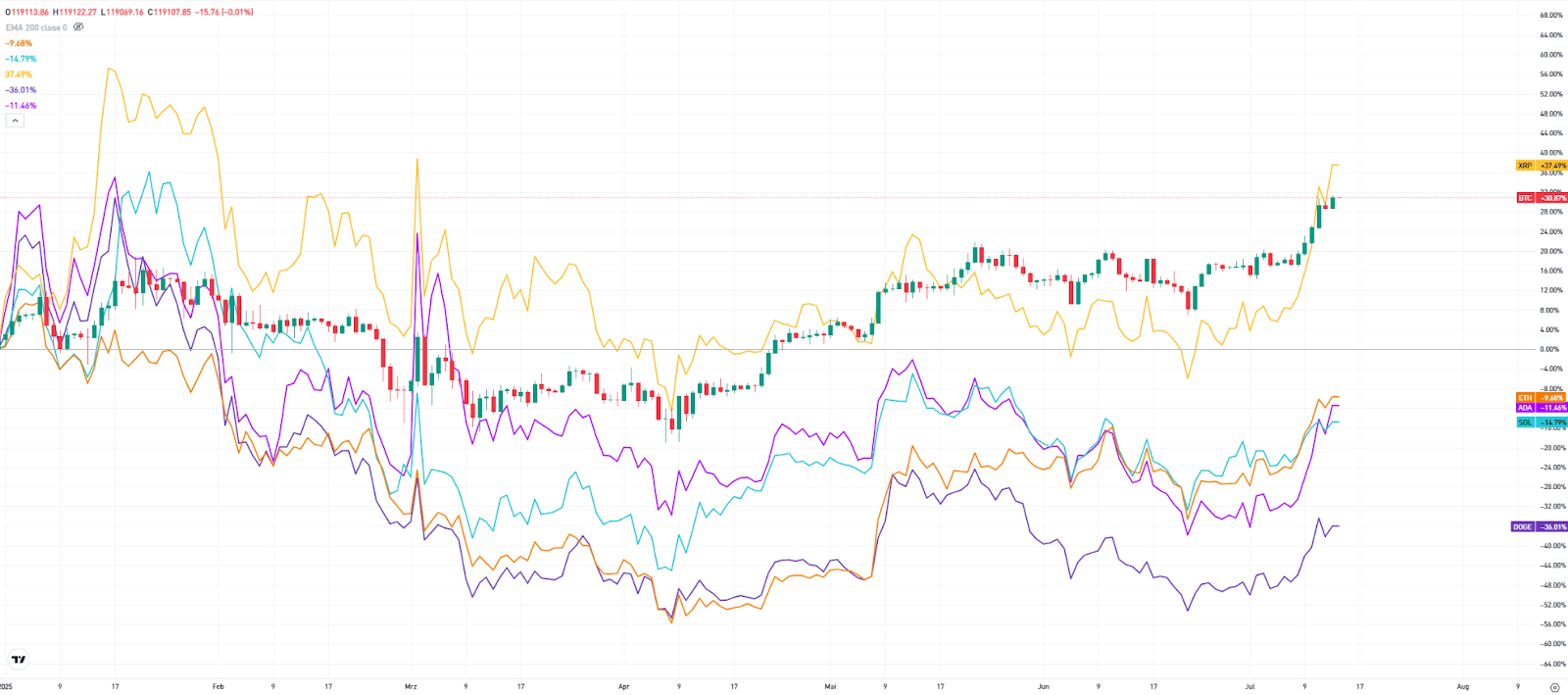Analyst Weekly, July 14, 2025
Banks First, Big Tech Soon
The official start to Q2 earnings season is here. Banks take the stage first, but all eyes are on Communications (+31.8% EPS growth expected) and Technology (+17.7%), the two sectors set to lead this quarter. With the US dollar weakening, Tech may get a further boost thanks to its large share of foreign-sourced revenue.
On the other end, Energy is once again the earnings anchor, with a projected 25% decline. Strip it out, and S&P 500 earnings are set to grow 7.7%, not just 5.8%. This is now the fifth straight quarter that Energy has dragged on aggregate earnings.
Topline Watch: Revenue Growth Tracks Nominal GDP
Q2 revenue growth is pegged at 3.7%, roughly in line with nominal GDP trends. Tech (12.6%) and Health Care (7.9%) are again leading. Energy lags, pressured by lower YoY oil prices.
This quarter should offer clearer insight into the impact of tariffs, which were in effect for nearly the entire reporting period. While the extension of the trade deadline may prolong corporate decision paralysis, the passing of tax legislation has at least removed one layer of business uncertainty.
2025 & 2026 Outlook: 7% Now, 14% Later?
Consensus sees full-year 2025 S&P 500 EPS at $262.61, a solid 7.1% annual growth rate. 2026 estimates call for a sharp rebound to 14% growth, pushing EPS near the $300 mark.
There’s potential for an upside surprise in consumer services, especially travel and leisure, given resilient consumer spending trends observed in Q2. But with valuations back at cycle highs, interest rates, not earnings, will likely determine whether multiple expansion continues.
Margins Matter (Still)
Operating margins are climbing again, now at 17.8% and trending higher. Historically, margin stability has acted as a buffer against major market pullbacks. If this trend holds, it strengthens the case for continued gains in share prices through the rest of the earnings season.
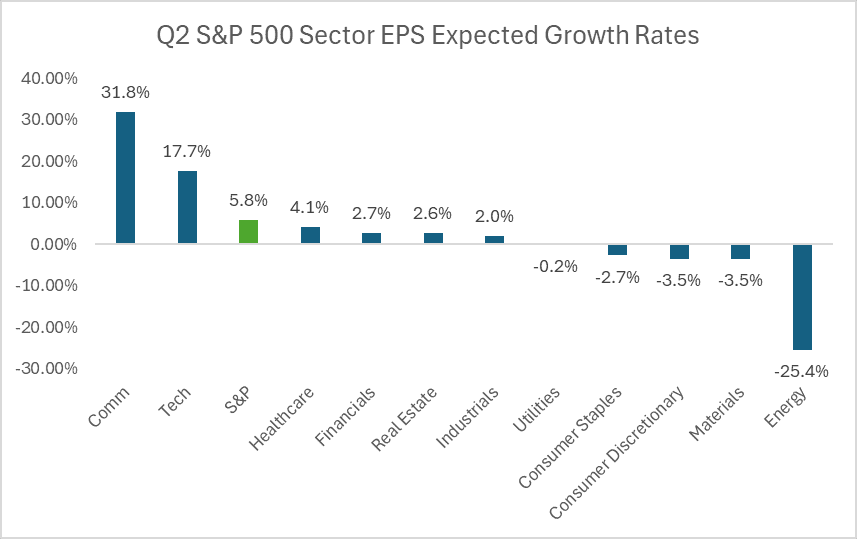
Source: Bloomberg, Factset, June 11, 2025.
VIX Hits Lows But Don’t Sleep on August
The VIX closed below 16 for the first time since February, extending a stretch of market calm as breadth improves and NVDA became the first company to cross the $4 trillion mark. The front end of the VIX futures curve remains notably steep, which usually signals that traders expect volatility to rise from these compressed levels, but not just yet.
With Q2 earnings season beginning and July historically a strong month, seasonality favors continued calm. We’ve now moved past several potential volatility triggers – G7, the tax bill, the tariff deadline, and debt ceiling risks – all of which either passed quietly or were delayed.
Investor Positioning: Confidence, Not Caution
Despite technicals showing overbought conditions, with persistent call demand across NVDA, TSLA, AAPL, and SPY, along with continued put selling, a signal of strong investor confidence. This mirrors a multi-week theme in the options landscape where hedging remains light and upside exposure remains in demand.
But Don’t Forget August…
While July tends to bring stability, August is often one of the more volatile months of the year, a risk worth monitoring, especially as earnings reports and Fed expectations evolve. For now, the market seems comfortable consolidating gains, but volatility seasonality says a reawakening could be on deck.
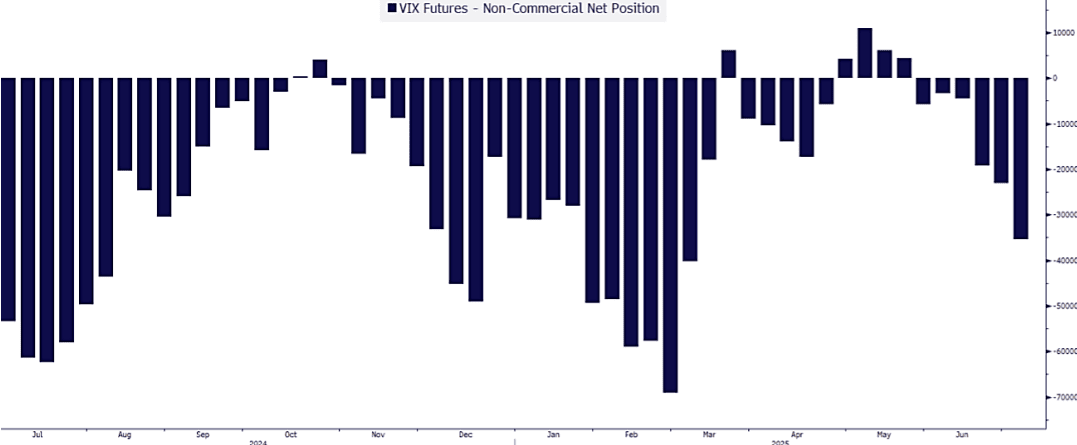
TSMC Q2 2025 Earnings Preview: High Hopes, High Hurdles
TSMC is set to report its second-quarter results on 17 July, and expectations are running high. The world’s largest contract chipmaker already gave a strong signal in its monthly revenue updates: sales were up 39% year-on-year in the June quarter, confirming robust demand across its advanced nodes. This performance supports the bullish thesis of investors who see TSMC as a long-term AI enabler.
The optimism stems from both short-term momentum and long-term fundamentals. TSMC is a critical supplier to clients like NVIDIA, Apple and AMD, all of whom rely on its cutting-edge chips for AI training, datacenters, mobile devices, and a rapidly increasing number of software applications. The company is expanding production in high gear, with new fabs under construction in Taiwan, the US, Japan, and the EU. This global footprint not only diversifies geopolitical risk but also positions TSMC to capture future demand.
Analysts estimate a compound annual revenue growth (CAGR) of 15–20% over the next three years, driven by AI-related chips and high-performance computing. In Q2 2025, TSMC is expected to generate over $10 billion in free cash flow, with projections suggesting annual free cash flow could exceed $40 billion by 2027, depending on capex levels.
Valuation remains a key talking point. TSMC currently trades at a forward P/E ratio of around 19, a premium compared to its historical average, but still below some US semiconductor peers. For some investors, that leaves room for upside if the AI boom sustains and margin expansion continues.
However, others caution against excessive optimism. Key risks include export restrictions to China, which still accounts for a significant portion of TSMC’s revenue. The geopolitical tensions around Taiwan also remain unresolved. Meanwhile, building multiple fabs in parallel increases execution risk, especially in regions where TSMC has no operating track record. And while demand is strong now, some analysts worry about potential overcapacity from 2026 onwards if AI chip demand slows or efficiency gains reduce unit volumes.
In short, next week’s earnings will give investors a clearer read on whether TSMC’s performance, and its outlook for the remaining months of 2025, can justify the current valuation. The debate over whether it’s a buy will likely intensify, not conclude.
Banks in Focus: How Strong is the Impact of US Policy?
Big banks are kicking off earnings season this week. Second-quarter results are especially relevant for investors, not only because banks traditionally open the season, but also because they play a vital role in the global financial system’s infrastructure.
These earnings will provide insight into how significantly US policies have impacted the economy so far. Investors should focus on key indicators such as net interest margin, loan demand, credit quality, fee income, and trading revenues.
Markets remain optimistic for now. The S&P 500 gained 11.0% in Q2, its strongest quarterly rise since 2023, and closed at a new record high. The earnings season will reveal whether this rally is justified or if the effects of trade policy have been underestimated. The greater the deviation from expectations, the stronger the potential market reaction.
So far, U.S. economic data has shown surprising resilience to the ongoing trade dispute. For investors with direct exposure to bank stocks, attention should also be paid to any commentary on dividend policy and share buyback plans.
Tuesday will bring earnings from BlackRock, Citigroup, JPMorgan, and Wells Fargo. On Wednesday, Bank of America, Goldman Sachs, and Morgan Stanley will follow. All reporting before the U.S. market opens.
Expectations for the financial sector are for 2.4% earnings growth in Q2 compared to the previous year—well below the broader S&P 500 forecast of 4.8%. Revenue growth for financials is expected at 4.7%, slightly above the S&P 500 average of 4.2%.
Over the past three months, the financial sector has returned 14.8%, a solid performance but still well behind technology at 33.2% and industrials at 22.1%. This week will show whether financial stocks can catch up.
Are Altcoins Ready to Catch Up?
It currently feels as if the crypto party is starting up again. Bitcoin ended last week at a new all-time high of around $119,000. The breakout has renewed hopes for a new bull run. Back in early and late 2024, similar rallies followed the breakout of key resistance levels, each lasting for several weeks.
Most altcoins have lagged behind Bitcoin since the beginning of the year (see chart). Only XRP has kept pace, while Ethereum, Solana, Cardano, and Dogecoin remain significantly in the red. However, in recent weeks, buying activity in these coins has picked up again. A continuation of the Bitcoin rally could help restore confidence in the broader crypto market.
Crypto Comparison – Performance Year-to-Date (Daily Chart)
Copper Hits Record High: Tariffs Shock the Market
Copper prices surged more than 10% last week, closing at a new record high of $5.578 per pound. At one point, prices even reached $5.884.
The main driver behind the rally was the announcement of 50% tariffs on copper imports starting August 1. Copper is an essential raw material, widely used across industries including automotive, construction, data centers, renewable energy, and manufacturing.
Adding to the pressure, the U.S. lacks sufficient domestic copper production capacity. This could lead to significant price premiums in the U.S. market over the long term.
From a technical perspective, key support is located at last week’s low of $4.970, where the latest upward move began. An additional important level is $5.200, which acted as a resistance multiple times in 2024 and now appears to be serving as a support.
Copper Price (Daily Chart)
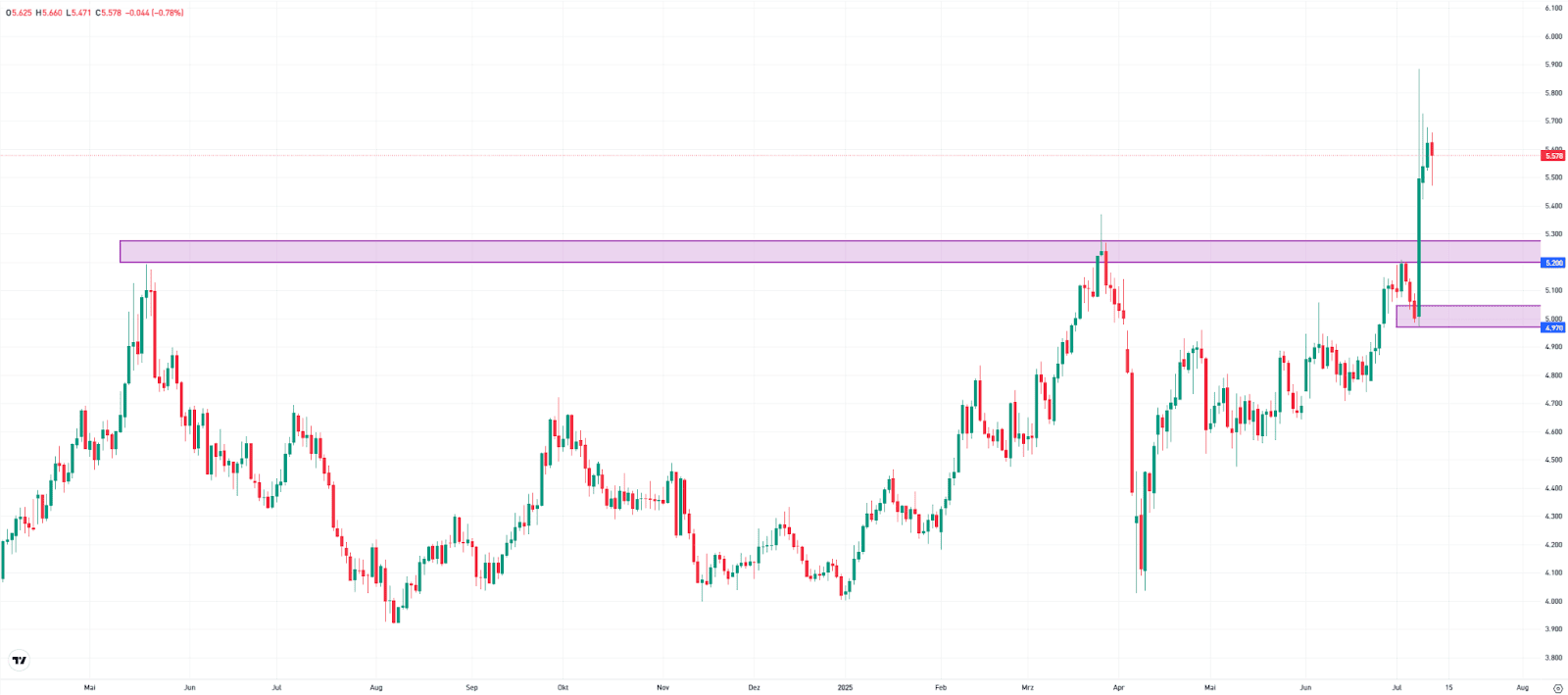
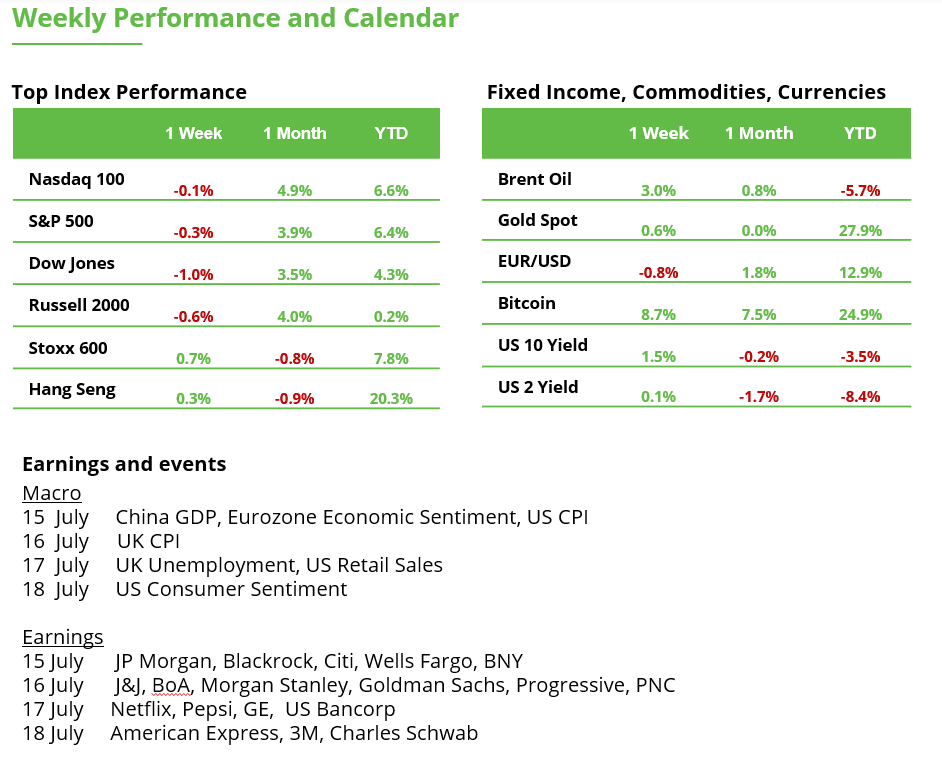
This communication is for information and education purposes only and should not be taken as investment advice, a personal recommendation, or an offer of, or solicitation to buy or sell, any financial instruments. This material has been prepared without taking into account any particular recipient’s investment objectives or financial situation and has not been prepared in accordance with the legal and regulatory requirements to promote independent research. Any references to past or future performance of a financial instrument, index or a packaged investment product are not, and should not be taken as, a reliable indicator of future results. eToro makes no representation and assumes no liability as to the accuracy or completeness of the content of this publication.







